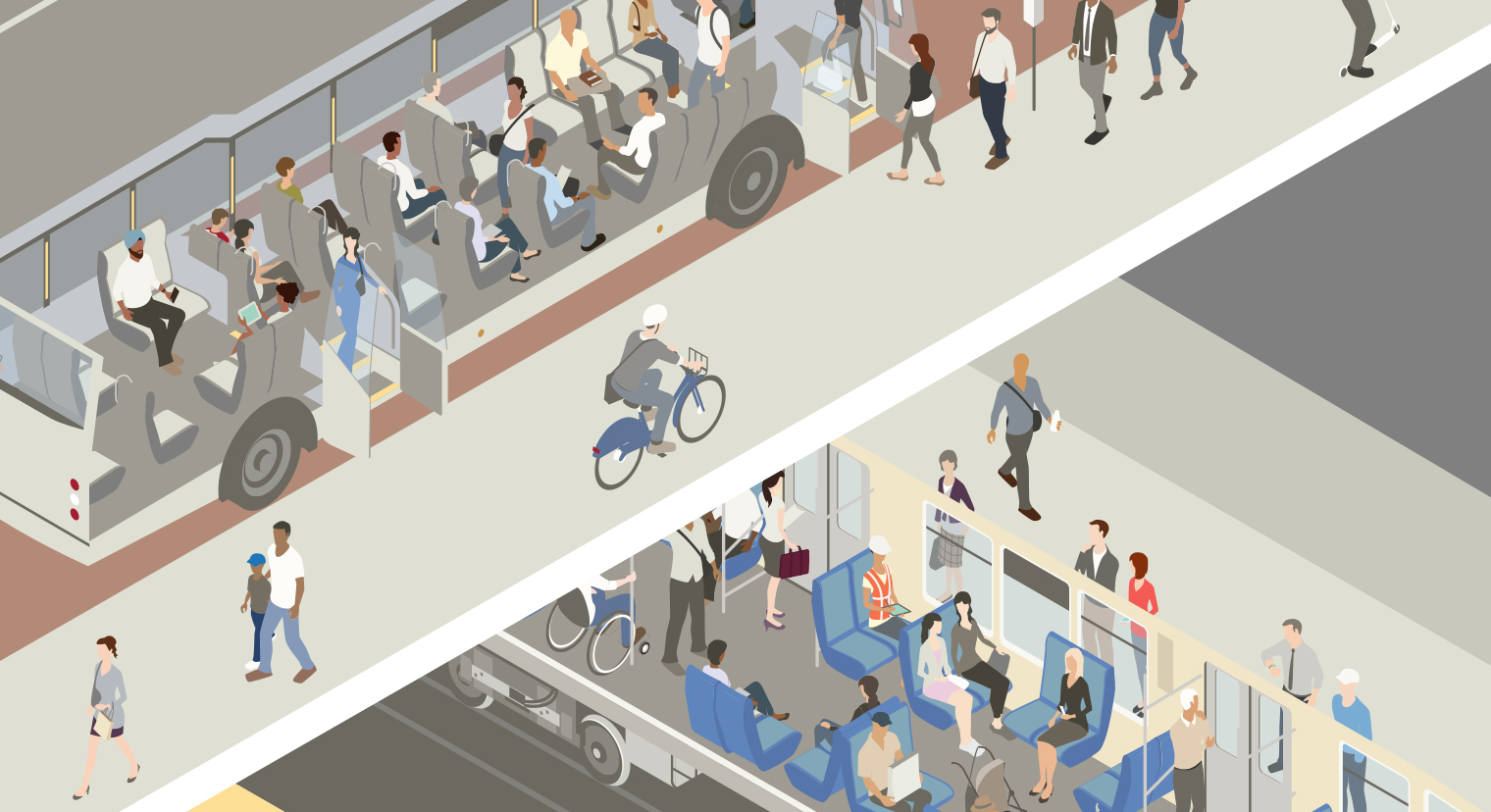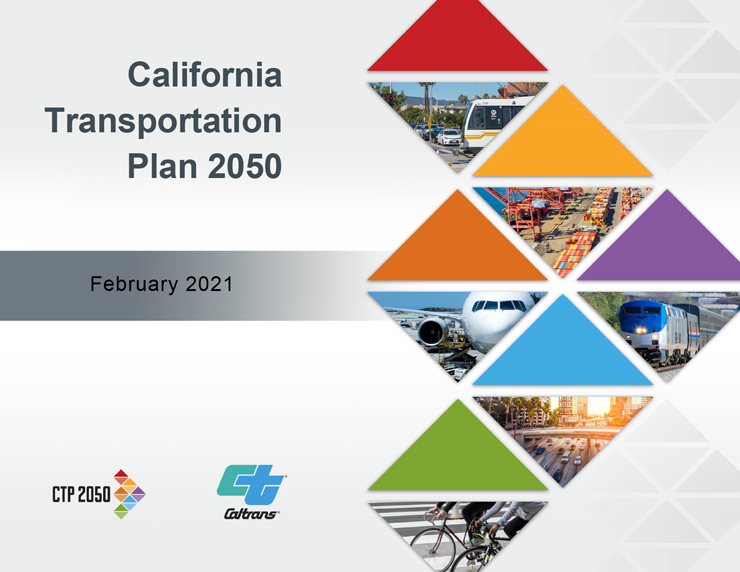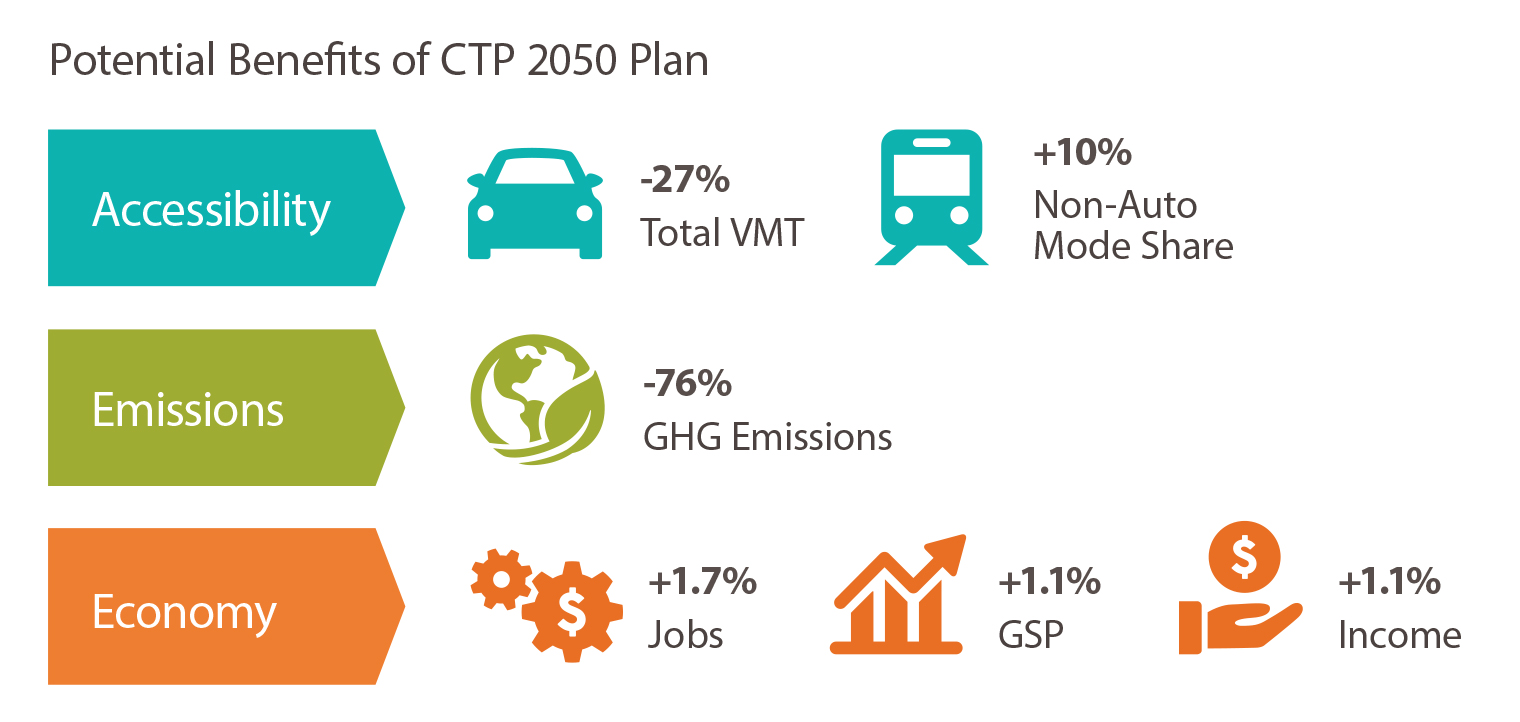Heading in a New Direction

California Transportation Plan 2050 Offers Roadmap to Cleaner, Fairer, Safer System Through Next Three Decades

The California Transportation Plan (CTP) 2050 details the state's long-range transportation vision and establishes a series of recommendations to improve mobility and accessibility while reducing greenhouse gas (GHG) emissions related to transportation.
The product of far-reaching climate legislation, the CTP 2050 presents an ambitious vision of California’s transportation future unconstrained by current policies and financial considerations, rather than focusing on individual projects or budgets. The goal of the plan is to create a roadmap for a travel system that, through the use of transportation and land use strategies, reduces emissions significantly by 2050 and is equitable, safe, sustainable, integrated and efficient for all.
Toward that end, the CTP 2050 has established eight goals to guide policy and budget decisions and transportation planning in the years ahead.
By 2050, the plan says California’s transportation system is expected to support an estimated 45 million residents. They will need an integrated, sustainable network of mobility options that provide safe, convenient and reliable access to jobs, education, health care and other services that improve quality of life in all regions of the state. California must do this while also achieving its goal of reducing GHG emissions from transportation to 80 percent below 1990 emissions levels by 2050.
The CTP 2050 shows how California can dramatically reduce climate-changing emissions from the transportation sector and comply with an ambitious slate of climate legislation through strategies to support a vibrant economy and livable communities, such as:
A transportation system for all Californians

The CTP 2050 also seeks to advance racial and economic justice. It proposes that new resources be directed to marginalized and underinvested communities, and existing resources be evaluated with the goal of amplifying voices that have been historically excluded from the transportation decision-making process. The plan emphasizes the importance of engagement and careful planning to ensure all Californians enjoy the benefits of transportation projects and are not subject to negative project impacts, particularly in historically underserved and underrepresented communities.
Improving engagement in transportation planning at the neighborhood level will help Caltrans better understand the travel needs and challenges for people in underserved communities. As a result, the department can improve transportation investments to limit those communities’ exposure to pollution from the transportation system, provide expanded mobility options, and enhance access to jobs, education, healthy food and transit.
In the plan, Caltrans and its policy advisory committee partners identify eight goals — along with accompanying objectives and performance measures:
- Safety — Provide a safe and secure transportation system.
- Climate — Achieve statewide GHG emission reduction targets and increase resilience to climate change.
- Equity — Eliminate transportation burdens for low-income communities, communities of color, people with disabilities and other disadvantaged groups.
- Accessibility — Improve multimodal mobility and access to destinations for all users.
- Quality of Life and Public Health — Enable vibrant, healthy communities.
- Economy — Support a vibrant, resilient economy.
- Environment — Enhance environmental health and reduce negative transportation impacts.
- Infrastructure — Maintain a high-quality, resilient transportation system.
During development of the CTP 2050, California saw a sudden sharp dip in travel demand due to the COVID-19 pandemic. Caltrans saw a clear need to reevaluate many of the underlying assumptions about future travel in the scenarios analyzed through the CTP, even as the technical work on the plan was nearly complete. Higher levels of telework can be expected permanently, and the need for rapid broadband deployment has increased. Expanding access to transit and safe walking and bicycle paths were priorities for Caltrans before the arrival of COVID-19 and remain essential to achieving a sustainable recovery.
Cleaner air, less congestion, stronger economy

The plan foresees significant benefits if its recommendations are implemented.
The CTP provides a path toward achieving the state’s GHG emissions target of 80 percent below 1990 levels by 2050. Correspondingly, vehicle miles traveled (VMT), the measure that Caltrans uses to gauge traffic impacts, could drop by 27 percent from a 2050 scenario based on current trends if other modes of travel such as walking, bicycling, skating and public transit are supported. Trips taken using these options could jump 10 percent if projections are met, the plan says.
Transportation improvements also would strengthen the state’s economic standing, according to the CTP 2050, by creating jobs, improving access to workplaces and services, and ensuring that goods move efficiently between businesses, consumers and the global marketplace. The plan predicts robust investment in the transportation network could generate a half-million new jobs, boost the gross state product an additional $1 billion and net California workers an additional $33 billion in income.
Conversely, the CTP 2050 warns of increases in VMT of up to 35 percent by 2050 and further degradation of California’s transportation network without the right mix of system investments and land use decisions. In addition, the amount of time Californians spend stuck in traffic could double by 2050 without intervention.
The plan also describes how travel is changing, in ways that pose challenges and opportunity. Broadband and internet connectivity are allowing people to work, shop, learn, and obtain health services from home — a trend that accelerated during the COVID-19 pandemic. Vehicle electrification is already helping reduce transportation sector emissions, yet vehicle automation may make driving more appealing. Generational lifestyle differences, such as waning auto-ownership among youth populations, could change traditional travel modes, as will the waves of evolving data and information technology.

Implementing the plan will require diligence
Achieving the goals of the CTP 2050 will not be easy. The plan is ambitious and seeks to enhance the future transportation system of California. Through the process of CTP 2050 implementation, Caltrans must work with its partners to transition the policies within the document into plans, programs and projects.
The CTP 2050 recommendations are based on technical analysis that explored how socioeconomic trends, land use shifts, changes in travel preferences, and other factors will affect future transportation system performance, and impacts on emissions and economic growth. Plan projections are based on three performance modeling tools that analyzed travel demand, emissions generation, and economic trends.
The CTP is updated every five years according to state and federal law. Caltrans developed the plan over a two-year period that included extensive public outreach; engagement from state, local, and regional partners; research and analysis; and oversight from four committees and eight groups of subject matter experts.
The CTP 2050 also draws from, and unifies, Caltrans modal plans and other statewide transportation-related plans.
Following adoption of the CTP 2050, Caltrans is now developing an implementation element that outlines transportation agency responsibilities, implementation steps, and timelines. The implementation process will inform the next iteration of the CTP, which is expected to conclude in 2025.
Source: California Transportation Plan 2050; Caltrans Division of Transportation Planning

